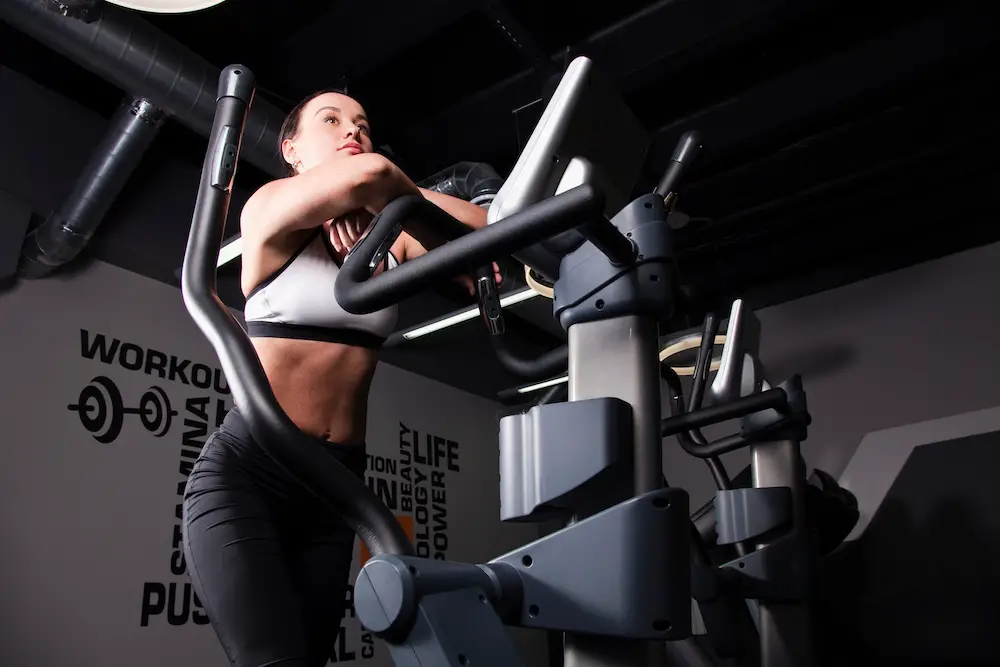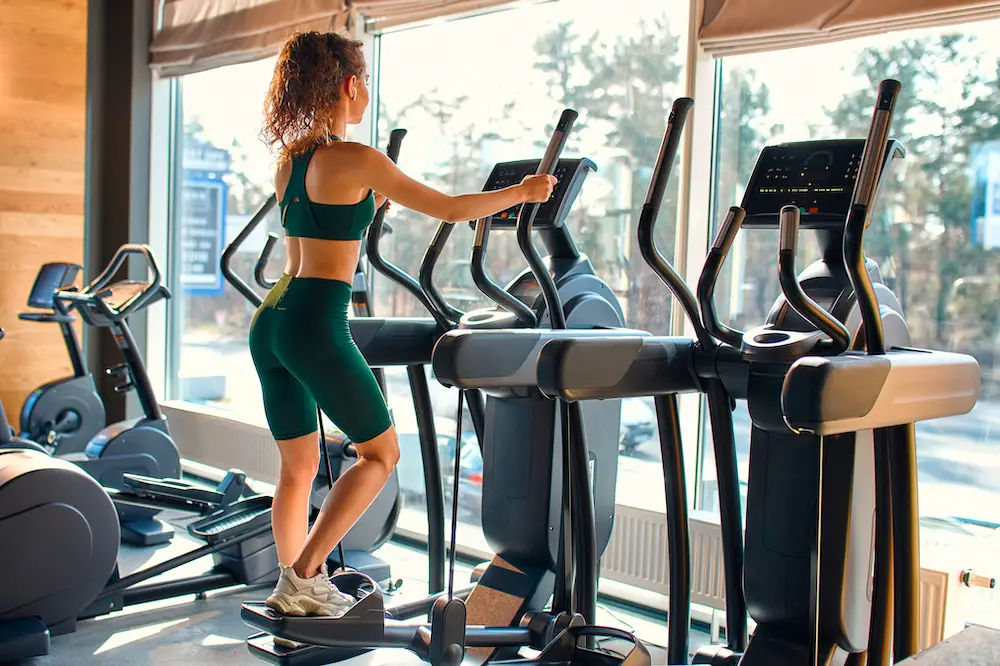The elliptical machine, also known as an elliptical trainer, is one of the best pieces of exercise equipment that help improve the body.
It’s currently on the list of the most popular total-body exercise machines and is widely sought after by many gym managers and even home gym owners.
With this level of fame, one can’t help but wonder what muscles are used on an elliptical machine.
Why is it highly in demand? How does it help achieve overall wellness? We have the answers here for you.
What Muscles Are Used on an Elliptical Machine?
Elliptical training is a one-size-fits-all type of exercise.
It allows you to improve individual muscles in your body with just a few forms of repetitive movements.
Understanding what muscles are used on an elliptical machine will help you maximize your workout routines because you’ll know how to move your body.
Hamstrings and Glutes
The hamstrings are the group of muscles at the back of your legs.
These muscles are responsible for leg and knee extension, which is crucial in all sorts of elliptical aerobic exercises.
When you step on the elliptical, you push the pedals with your feet, which then causes leg flexion, kind of like when you’re climbing up a hill.
As you can imagine, this movement puts your hamstring muscles under considerable pressure.
Some elliptical cross-trainer exercise machines will even allow you to reverse your legs’ motion.
As a result, this provides more emphasis on the hamstrings compared to when you’re exercising with the initial movement pattern.
That’s because the hamstrings need to assist with leg and hip extensions, which are more prominent when you move your thighs backward.
Aside from the hamstrings, this method of exercising on the elliptical targets the glutes or gluteus Maximus.
The glute muscles are basically your buttocks, and they also assist in hip extension.
Increasing the incline of the machine will further require you to extend your hips, which then increases the pressure on the hamstrings and glutes.
Quads
The quads or quadriceps are comprised of four individual muscles found in front of your thigh.
The quads are also activated along with the hamstrings and glutes during knee extension.
If you’ve exercised on a stationary bicycle, you’d know the sensation of your quads working. That said, this is not the case for elliptical machines.
You may not initially feel your quads at work, but every time you straighten your legs when you step on the pedals, your quads also receive pressure.
That’s because elliptical exercises divide the pressure between the glutes, hamstrings, and quads, resulting in the holistic development of the legs.
For the same reason, you also will not exhaust your quads as fast as you would on a stationary bicycle.
This is why elliptical training is considered a low-impact workout. You don’t necessarily have to put too much power on each of your muscles.
The consistency and adequate pressure and tension on the leg muscles allow you to go for a longer period, getting almost similar results.
Calves
Your calf muscles are below your hamstrings and quads. It is the group of muscles in your lower legs running from the knees to the ankles.
The calves are responsible for keeping your balance while on the elliptical machine.
One main difference between the calves and your other leg muscles is that they don’t get larger through basic workouts.
Nonetheless, calf muscles pack incredible power when they are developed. This is because the calves are partially responsible for keeping your entire body upright.
It is also why developing your calves is very important.
Keeping your lower body powerful will significantly reduce the risk of injuries when performing different types of body workouts or daily activities.
Well-developed calves can also be beneficial to cardiovascular endurance.
Cardiovascular workouts often involve running, walking, or standing, which are all tasks for your calf muscles.
When you’re on the elliptical, your calves press on the ball of your feet and against the foot pedals.
This positioning causes your calves to perform a muscle movement called plantarflexion.
Adjusting the inclination of the machine will cause your calf muscles to perform harder, boosting their development.

Arms, Chest, and Back
You might think that elliptical machines only develop your lower body. However, you have to remember that there are many ellipticals with arm motion, as well.
So, as you push the pedals down with your feet, you must also push and pull the elliptical handles with your arms.
This upper body movement engages the arm, chest, and back muscles.
The “pushing” muscles are the ones in the back of your arms and those that support your chest. These are called the triceps and pectoral muscles, respectively.
On the other hand, the “pulling” muscles activate when you bend your arms. The biceps primarily do this when you flex your elbow.
They are assisted by another muscle group called the rhomboid, which is responsible for pulling the shoulder blades together.
If you want to put more focus on developing your biceps and back muscles, you can set the machine in reverse.
On the other hand, keeping it in the standard setting develops your triceps and chest.
Whichever setting you use will engage all the muscles in your upper body.
This allows you to develop the muscles necessary for strength training, which is very effective if you’re trying to burn more calories.
Core Muscles
When done correctly, your elliptical session will also engage your core, which is your abdominal muscles.
This means that aside from losing weight, an elliptical machine can also tone your stomach and get rid of belly fat.
It can only be possible if you exercise on the elliptical with a proper posture.
The core muscles are engaged when you maintain the perfect balance on the machine. This means you should not lean your weight on the elliptical handles.
Because it’s right in the middle of your body, developing your core muscles is crucial to all your fitness pursuits.
Aside from muscle toning, a strong abdomen will significantly boost muscle endurance during low to high-intensity exercises.
Moreover, developing your core can reduce symptoms of back pain and improve your body posture.
How To Use Elliptical Machine
An effective workout on the elliptical means you are able to target the major muscle groups we listed. It will not be possible if you don’t use the machine properly.
Here’s how you can make the most out of your elliptical training sessions:
1. Stand Straight
Before anything else, you need to make sure you have proper posture while using the machine.
Otherwise, you are putting yourself at risk of injury and intense muscle strain.
Do not hold your shoulders high up to your ears but don’t lean back, as well. Keep your body perpendicular to the floor even while you’re in motion.
If you find yourself getting tired, you can always reduce the resistance or inclination. Doing so will ensure you maintain your posture and don’t slouch.
2. Move the Handles Along With Your Feet
The next step is to push and pull the movable handles while you step on the pedals with your feet.
Again, make sure you’re not leaning your weight on the handles. The handles will independently move because of the leg movement you exert on the pedals.
Do not just let your arms move with the handles. Instead, use your strength to move them to guarantee you’re engaging your upper body properly.
Additionally, make sure you’re not putting your weight on your toes. If you do, you will be putting too much strain on your knees.
The movement of your feet should remain natural, just as you would when running, climbing, or walking on pavement. This distributes your weight evenly on your feet.
One way to guarantee this is to ensure the entire length of each foot rolls through the pedal as you move.
3. Increase the Resistance Level
Elliptical machines are designed for low-impact exercises. However, this does not mean you should not take advantage of its features.
Halfway through your fitness routine, try to increase the resistance level and lower it again when you start getting tired.
Doing this allows you to improve your endurance while increasing your muscle strength.
4. Use the Incline Option
The default inclination of your machine is zero, which is like running on a paved road or a flat surface.
This is totally fine, but it does not burn calories as much as you would on an incline.
The higher the incline, the more you get to work your glutes and other muscles. You can manually adjust the incline while working out to boost your workout session.
5. Reverse
More advanced elliptical machines have the reverse option.
This feature allows you to perform your movement cycles in the opposite direction. This means the foot pedals and movable handles go backward instead of forward.
Doing this allows you to target specific muscles you don’t normally would with traditional exercises.
Building Muscles With an Elliptical
The elliptical cross-trainer is one of the best pieces of gym equipment you can use to achieve your fitness goals.
It engages almost all the muscles in your body, which is vital for muscle toning and improving your overall health.
Just be sure you know how to use it properly so that it targets the muscles you want it to.

